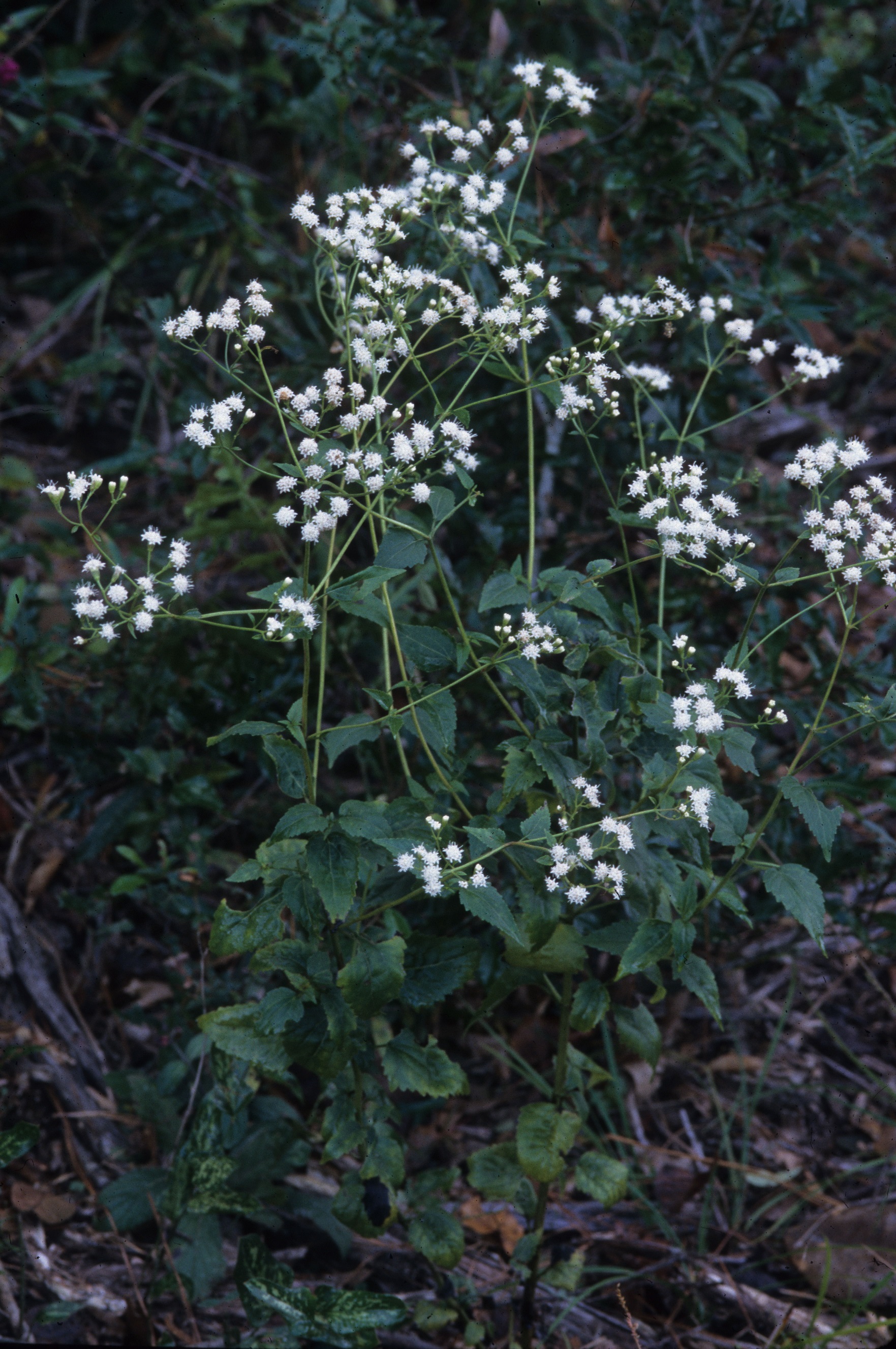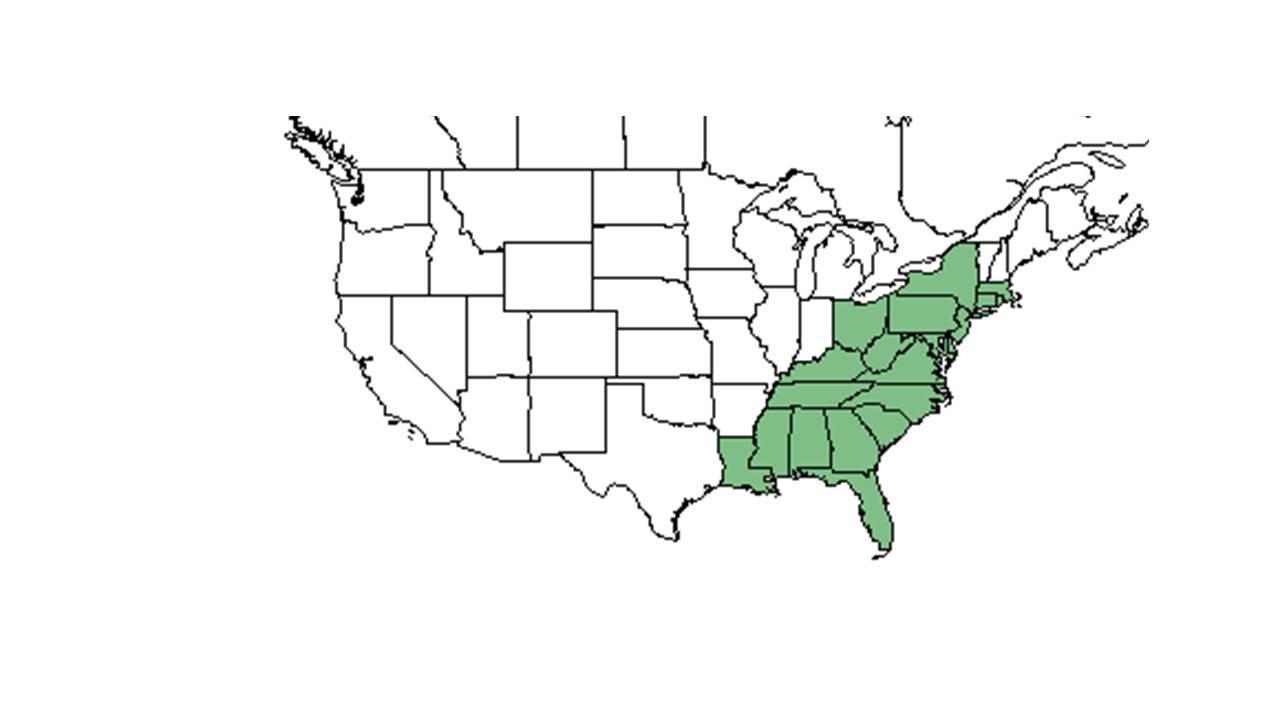Ageratina aromatica
| Ageratina aromatica | |
|---|---|

| |
| Photo taken by Gil Nelson | |
| Scientific classification | |
| Kingdom: | Plantae |
| Division: | Magnoliophyta - Flowering plants |
| Class: | Magnoliopsida - Dicotyledons |
| Order: | Asterales |
| Family: | Asteraceae ⁄ Compositae |
| Genus: | Ageratina |
| Species: | A. aromatica |
| Binomial name | |
| Ageratina aromatica (L.) Spach | |

| |
| Natural range of Ageratina aromatica from USDA NRCS Plants Database. | |
Common names: Lesser snakeroot; Wild hoarhound; Small-leaved white snakeroot
Contents
Taxonomic notes
Synonyms: Eupatorium aromaticum Linnaeus; Eupatorium latidens Small.[1]
Varieties: A. aromatica var. aromatica – K; A. aromatica var. incisa (Gray) C.F. Reed.[1]
The genus name Ageratina comes from the Greek word "agera" which means un-aging, not growing old in reference to the longevity of the flowers. The specific epithet comes from the Greek word "aroma" meaning spice seasoning.[2]
Description
A description of Ageratina aromatica is provided in The Flora of North America.
The lifepans of individual plants within the Wade Tract old-growth pine savanna in southern Georgia, based on multiple years of data from permanent plots, is several years, with genets that become established and flower persisting through 1 - several fires. No genet has been observed to survive more than about 4-5 years.[3]
Ageratina aromatica genets commonly are comprised of a single ramet or a few ramets within a few centimeters of each other, especially after fires have top-killed existing ramets. Underground the roots radiate from the base of the ramet stem and are thickened relative to most fibrous roots of composites. Below ground rhizomes often are not present, but if present are short. The compact growth form of flowering snakeroots in the old-growth pine savanna, consisting of one or a few closely spaced above-ground ramets, may differ from growth forms of genets in more open secondary forests.[4]
It can be distinguished from the closely related A. altissima[1] by having smaller, thicker, and less sharply toothed leaves on shorter petioles, smaller stature, smaller flower heads, and thicker roots, and shorter, firmer pubescence.[3]
Distribution
It is found from eastern Louisiana and Mississippi eastward to the Atlantic coast and northward to Pennsylvania and Massachusetts.[5] It is regionally rare in New England. In Massachusetts and Connecticut it is listed as endangered (S1) and in Rhode Island is historical only (SH).[3]
Ageratina aromatica is among the 20 most frequent ground layer plant species in mesic old-growth pine savanna on the Wade Tract, occurring in almost half the permanent plots in the ongoing long-term study.[4]
Ecology
Habitat
A. aromatica can be found in a variety of longleaf pine communities, mixed pine-hardwood forests, open oak woods, live oak woodlands, upland woodlands, and rolling red hills. It can also be found in disturbed habitat such as roadsides, along fences, and on the edges of fields.[6]
On the Wade Tract, A. aromatica occurs in open pine savanna along mid and lower mesic slopes, but tends to be absent from drier, sandy ridges. It often occurs in slightly disturbed areas of the Wade Tract, and it occurs in natural hardwood thickets as well.[4] Ageratina aromatica is considered a dominant plant species in post-agricultural longleaf pine savannas.[7]
This species is observed in a range of light conditions, from open forest situations to semi-shaded and shady areas. In the ground layer of pine savannas at Girl Scout Camp Whispering Pines in Louisiana, A. aromatica was neither positive nor negatively associated with understory light levels, suggesting broad tolerance of light conditions.[8]
It occurs most frequently in moist sandy loam, dry sand, and areas of lime rock.[6] A. aromatica became absent in response to soil disturbance by military training in west Georgia. It has shown resistance to regrowth in reestablished pinelands that were disturbed by this activity.[9]
Ageratina aromatica is an indicator species for the North Florida Longleaf Woodlands and Clayhill Longleaf Woodlands community types as described in Carr et al. (2010).[10]
Associated species include Chamaecrista fasiculata, Eupatorium album, Helianthus angustifolius, Liatris graminifolia, Solidago odora, Sorghastrum nutans, Pinus palustris, Pinus echinata, Aristida beyrichiana, Quercus, Liatris, and Dicerandra species and others.[6]
Phenology
It can spread vegetatively in a limited area, but it is dependent on sexual reproduction to colonize new areas.[3] Flowering occurs in the fall[11], and has been observed flowering in the months of October, November, and January with peak inflorescence in October.[12] It has been observed fruiting in October and November as well.[6]
On the Wade Tract, flowering occurs at the end of the growing season, in the latter part of October and November, following spring fires. At this time, A. aromatica often is the most abundant and conspicuous flowering composite in the ground layer of mesic savanna. The white inflorescences are at "canopy" height and form flat platforms of flowers visited by numerous bees and other flying insects in the late fall. Flowering may occur sporadically in years between fires, but is most noticeable as highly synchronized flowering displays across mesic landscapes on the Wade Tract following spring fires.[4]
In north Florida, it has been observed to reproduce with A. juncunda[2] suggesting these species are possibly conspecific.[13]
Seed dispersal and germination
This species is thought to be dispersed by wind.[14]
On the Wade Tract, achenes are wind-dispersed in the late fall/early winter. The achenes are light, but the small pappus results in seeds that tend to fall within the vicinity of the parent plant. Whether a seed bank is present is not known, but if present, it is likely only to be comprised of short-lived seeds. Germination has been observed in burned areas during the early summer following the onset of summer rains. Seedlings sometime are numerous around established plants. Survival of seedlings is very low, but the seedlings appear to be shade tolerant and can persist under the shade of other ground-layer plants. Seedlings in plots on the Wade Tract have reached a size such that they flower within 2-3 years. Nonetheless, many juvenile plants survive for several years before being killed in fires without ever flowering. Populations of A. aromatica on the Wade Tract thus tend to be multi-sized, but the short lifespan results in fairly rapid turnover within small areas.[4]
Fire ecology
Ageratina aromatica is found in annually burned savannas and wet pinelands.[6] It is the common ground cover species of North Florida Longleaf Woodlands, which are dependent on fire.[15] This species requires full to partial sun, therefore forest maturation and canopy closure resulting from a lack of disturbance such as fire can shade out A. aromatica.[3]
The nature of the population dynamics of A. aromaticaon the Wade Tract suggests that this species should be sensitive to fire suppression and other disturbances that reduce numbers of established plants, but also capable of rapid recovery if some plants survive the disturbances.[4]
Conservation, cultivation, and restoration
In New England, it is threatened by fire suppression and lack of disturbance that allows for canopy closure and forest maturation, resulting in lack of sunlight needed for A. aromatica to prosper.[3] It is listed as endangered in the state of Massachusetts. [16]
Cultural use
Photo Gallery
References and notes
- ↑ 1.0 1.1 Weakley, A.S. 2015. Flora of the southern and mid-atlantic states. Working Draft of 21 May 2015. University of North Carolina at Chapel Hill, Chapel Hill, North Carolina.
- ↑ [[3]]Alabama Plants. Accessed: March 22, 2016
- ↑ 3.0 3.1 3.2 3.3 3.4 3.5 [[4]]New England Wild. Accessed: March 22, 2016
- ↑ 4.0 4.1 4.2 4.3 4.4 4.5 William J. Platt, Unpublished data from ongoing long-term study of ground layer vegetation on the Wade Tract
- ↑ Hall, David W. Illustrated Plants of Florida and the Coastal Plain: based on the collections of Leland and Lucy Baltzell. 1993. A Maupin House Book. Gainesville. 100. Print.
- ↑ 6.0 6.1 6.2 6.3 6.4 .Florida State University Robert K. Godfrey Herbarium database. URL: http://herbarium.bio.fsu.edu. Last accessed: June 2014. Collectors: Loran C. Anderson, Robert Blaisdell, Andre F. Clewell, William B. Fox, J. P. Gillespie, Robert K. Godfrey, C. Jackson, Gary R. Knight, R. Komarek, Robert Kral, Robert L. Lazor, Sidney McDaniel, Richard S. Mitchell, P. L. Redfearn Jr., V. I. Sullivan, Jean W. Wooten, and Geo. Wilder MacClendons. States and Counties: Florida: Bay, Calhoun, Escambia, Franklin, Gadsden, Gulf, Holmes, Jackson, Jefferson, Leon, Levy, Liberty, Madison, Okaloosa, Putnam, Santa Rosa, St. Johns, and Wakulla. Georgia: Grady.
- ↑ Ostertag, T. E. and K. M. Robertson (2007). A comparison of native versus old-field vegetation in upland pinelands managed with frequent fire, south Georgia, USA. Proceedings of the 23rd Tall Timbers Fire Ecology Conference: Fire in Grassland and Shrubland Ecosystems, Tallahassee, Tall Timbers Research Station.
- ↑ Platt, W.J., S.M. Carr, M. Reilly, and J. Fahr. 2006. Pine savanna overstorey influences on ground-cover biodiversity. Applied Vegetation Science 9:37-50.
- ↑ (2002). Understory vegetation indicators of anthropogenic disturbance in longleaf pine forests at Fort Benning, Georgia, USA. Ecological Indicators 1(3):155-170.
- ↑ Carr, S.C., K.M. Robertson, and R.K. Peet. 2010. A vegetation classification of fire-dependent pinelands of Florida. Castanea 75:153-189.
- ↑ Wunderlin, Richard P. and Bruce F. Hansen. Guide to the Vascular Plants of Florida. Second edition. 2003. University Press of Florida: Gainesville/Tallahassee/Tampa/Boca Raton/Pensacola/Orlando/Miami/Jacksonville/Ft. Myers. 295. Print.
- ↑ Nelson, G. PanFlora: Plant data for the eastern United States with emphasis on the Southeastern Coastal Plains, Florida, and the Florida Panhandle. www.gilnelson.com/PanFlora/ Accessed: 4 MAR 2019
- ↑ Clewell, A. F. and J. W. Wooten (1971). "A Revision of Ageratina (Compositae: Eupatorieae) from Eastern North America." Brittonia 23(2): 123-143.
- ↑ Kirkman, L. Katherine. Unpublished database of seed dispersal mode of plants found in Coastal Plain longleaf pine-grasslands of the Jones Ecological Research Center, Georgia.
- ↑ Carr, S. C., K. M. Robertson, et al. (2010). "A Vegetation Classification of Fire-Dependent Pinelands of Florida." Castanea 75(2): 153-189.
- ↑ USDA Plants Database URL: https://plants.usda.gov/core/profile?symbol=ANGE